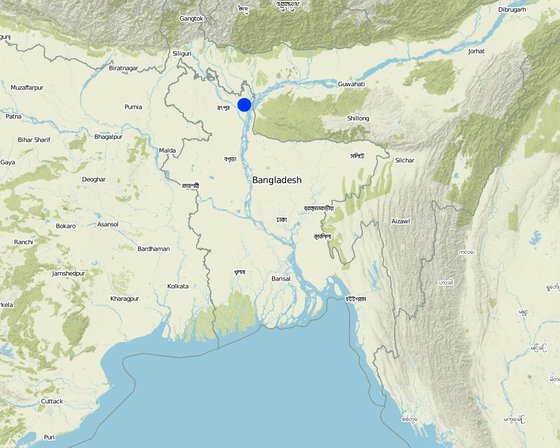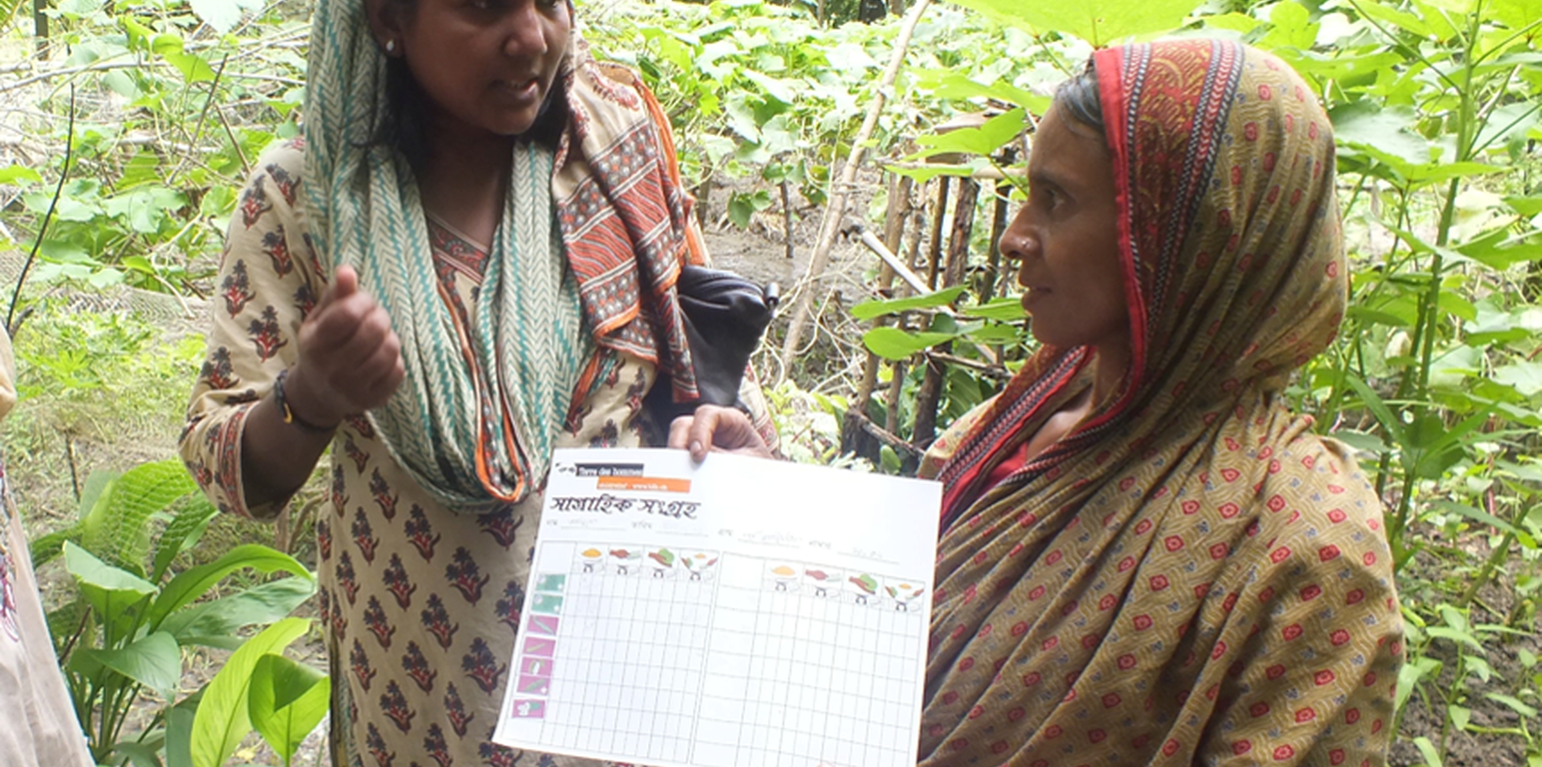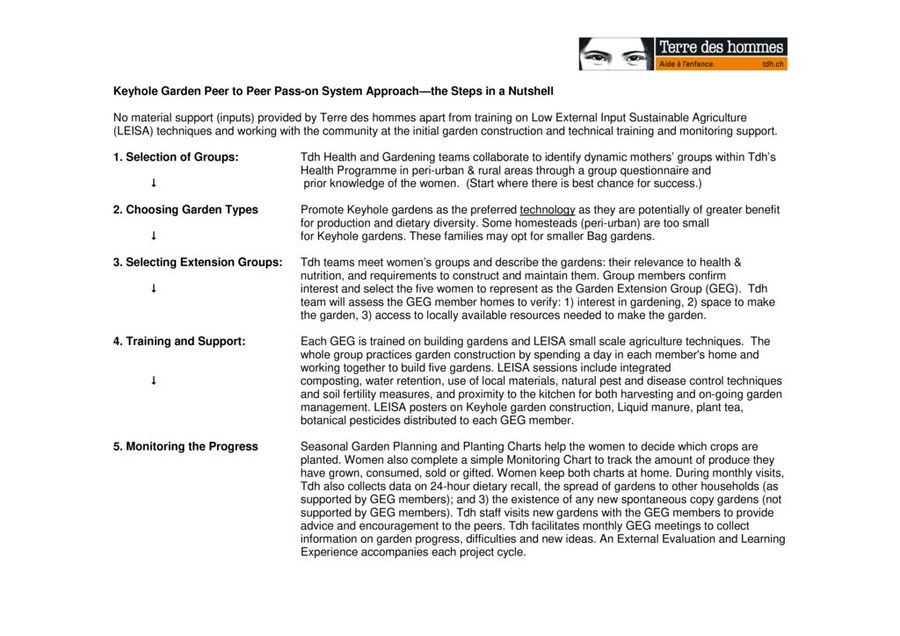Peer to Peer Pass-on Approach with Women
(Бангладеш)
Тодорхойлолт
Terre des hommes and Greendots introduced the Peer to Peer pass-on system to enable women's groups in Bangladesh to spread the Keyhole Garden technique within their communities with the aim of enabling year-round homestead vegetable production despite the risk of flooding and tidal surge.
Keyhole Gardens, a type of small, productive homestead vegetable garden based on Low External Input Sustainable Agriculture (LEISA) techniques, have been used in various African countries for over 15 years and shown to increase the availability of food and dietary diversity (FAO). They were developed by gardeners and small-scale farmers (with the support of Send a Cow UK) to suit different situations, such as the cold, dry winters of Lesotho, the small backyards of Rwanda, and the humid heat of central Uganda. To improve year-round homestead nutritional self-sufficiency for vulnerable families in South Asia (where rates of acute malnutrition in young children regularly cross emergency thresholds), Keyhole gardens were adapted by Terre des hommes (Tdh) and Greendots to the conditions of river basin and coastal areas of Bangladesh (and eventually to India's Sundarbuns) . As a component to Tdh's maternal neonatal and child health (MNCH) programme, the technology is intended to support year-round homestead gardening despite weather extremes (flooding, tidal surge, cyclones).
To promote spontaneous replication of the Keyhole gardening in the local communities, the programme initiated a Peer to Peer Pass-on system within 40 mothers' groups (having a total membership of nearly 800 women). Each mothers' group selected five representatives (200 women) to form a Garden Extension Group (GEG) and participate in the first round of training with the understanding that they would share knowledge with other women in the MNCH programme and the surrounding community. The project team trained each GEG on building gardens and LEISA small scale agriculture techniques (including integrated composting, water retention, use of local materials, natural pest and disease control techniques and soil fertility measures, proximity to the kitchen for optimal management and harvesting). GEG group members practiced garden construction by working together to build gardens at the homes of all five members. All 200 initial gardens were monitored by Tdh extension workers on a weekly basis. Tdh verified output, use and the capacity of gardens to withstand monsoon conditions, and the extent of the of the Peer to Peer Pass-on experience.
See the Chart in Section 3.3 for more information.
Байршил

Байршил: Kurigram municipality (Kurigram District), Patharghata Union (Barguna District), Kurigram District / Rajshahi Division and Barguna District / Barisal Division, Бангладеш
Сонгосон байршлуудын газарзүйн холболт
Эхлэх огноо: 2012
Төгсөх жил: тодорхойгүй
Арга барилын төрөл
-
уламжлалт / уугуул
-
Сүүлийн үеийн орон нутгийн санаачлага / шинэчлэл
-
төсөл / хөтөлбөр дээр үндэслэсэн

Practicing together building a Keyhole Garden (Peer to Peer Pass-on system) (S Taylor)
Арга барилын зорилго ба эерэг нөлөө
Арга барилын үндсэн зорилго, зорилт
The main aims of the approach are to involve women by building their capacity and peer network to replicate the Keyhole gardening approach within their communities.
The main objective of the approach is that that families, led by women 1) garden year-round with LEISA techniques, 2) increase the quantity and diversity of their homestead vegetable production and 3) verify that the DRR garden design reduces the consequences of flooding and tidal surge.
Тухайн Арга барилын хүрээнд нэвтрүүлсэн Технологийг хэрэгжүүлэхэд дэмжлэг болох нөхцлүүд
-
Нийгэм / соёл / шашны хэм хэмжээ, үнэт зүйлс: Acceptance of women's groups, existing mothers' groups within Health programme
-
ГТМ-ийн талаарх мэдлэг, техникийн дэмжлэг авах боломж: The Approach calls for capacity building on LEISA techniques (knowledge on SLM) via the Peer to Peer Pass-on system to spread the DRR-designed gardens.
Тухайн Арга барилын хүрээнд нэвтрүүлсэн Технологийг хэрэгжүүлэхэд хүндрэл учруулах нөхцлүүд
Талуудын оролцоо ба үүрэг
Арга барилд оролцогч талууд болон тэдгээрийн үүрэг
| Ямар оролцогч талууд / хэрэгжүүлэгч байгууллагууд арга барилд оролцож байсан бэ? |
Оролцогч талуудыг тодорхойлно уу |
Оролцогч талуудын үүргийг тайлбарлана уу |
| Орон нутгийн газар ашиглагч / орон нутгийн иргэд |
Homestead land users (women) |
Building the gardens: learning and eventually training their peers |
| олон нийтэд түшиглэсэн байгууллагууд |
Mothers' groups |
Garden extension groups to share the Keyhole Garden techniques within the scope of their maternal neonatal & child health & activities |
| ГТМ-ийн мэргэжилтэн/ хөдөө аж ахуйн зөвлөх |
Greendots (www.greendots.ch) |
Technical support with design of the approach: Daniel Varadi and Sheila Taylor. |
| Олон улсын байгууллага |
Terre des hommes (international NGO) |
Project implementing Agency, direct connection with women's groups within its MNCH Programme via Dr. Sultana Al-Amin (Gardening Specialist). |
Тэргүүлэх байгууллага
Terre des hommes
Арга барилын янз бүрийн үе шатанд орон нутгийн газар ашиглагчид / бүлгүүдийг татан оролцуулах
үгүй
идэвхигүй
Гадаад дэмжлэг
интерактив
өөрийн хүчийг нэгтгэсэн
санаачлага/идэвхжүүлэлт
Terre des hommes and Greendots working through existing women's MNCH nutrition groups, requested groups to nominate five women to receive the training.
Төлөвлөгөө
As with all village-level activities, Terre des hommes works with a community volunteer in each village to plan the training and group interventions.
Хэрэгжилт
Once the women were trained, they were free to honor their commitments to train other women.
Мониторинг/ үнэлгээ
Self planning and monitoring tools were introduced to the women--who decided whether to use them. Tdh provided monthly support visits to help interested women to update the planning and monitoring documents as needed, and to collect data.
Арга барил хэрэгжүүлэх бүдүүвч
ГТМ-ийн технологи сонгох шийдвэр гаргах явц
Шийдвэр гаргасан этгээд
-
Газар ашиглагч дангаараа (өөрийн санаачлага)
-
ГТМ-ийн мэргэжилтнүүдийн дэмжлэгтэйгээр, голчлон газар ашиглагчид
-
оролцооны зарчмын хэсэг болох бүх холбогдох талууд
-
голдуу ГТМ-ийн мэргэжилтнүүд, газар ашиглагчидтай зөвлөлдсөний үндсэн дээр
-
ГТМ-ийн мэргэжилтэн дангаараа
-
улс төрчид / удирдагчид
Шийдвэр гаргах үндэслэл нь
-
ГТМ-ийн мэдлэгийг баримтжуулалтын үнэлгээ (нотолгоонд суурилсан шийдвэр гаргах)
-
Судалгааны үр дүн, ололтууд
-
Хувь хүний туршлага ба санал бодол (баримтжуулаагүй)
Техникийн туслалцаа, чадавхи бий болгох болон мэдлэгийн менежмент
Дараах үйл ажиллагаа эсвэл үйлчилгээ нь арга барилын нэг хэсэг болсон
-
Чадавхи бэхжүүлэх/сургалт
-
Зөвлөх үйлчилгээ
-
Институцийг бэхжүүлэх (байгууллагын хөгжил)
-
Мониторинг ба үнэлгээ
-
Судалгаа
Чадавхи бэхжүүлэх / сургалт
Дараах сонирхогч талуудад сургалт хийсэн
-
Газар ашиглагчид
-
хээрийн ажилтан / зөвлөх
Сургалтын хэлбэр
-
Ажил дээр
-
фермерээс -фермер
-
үзүүлэнгийн талбай
-
Олон нийтийн уулзалт
-
курс дамжаа
Зөвлөх үйлчилгээ
Зөвлөх үйлчилгээ үзүүлсэн
-
Газар ашиглагчийн талбай дээр
-
Тогтмол төвд
Мониторинг ба үнэлгээ
Санхүүжилт болон хөндлөнгийн материаллаг дэмжлэг
ГТМ-ийн бүрэлдэхүүн хэсгийн жилийн төсөв ам.доллараар
-
< 2,000
-
2,000-10,000
-
10,000-100,000
-
100,000-1,000,000
-
> 1,000,000
Precise annual budget: тодорхойгүй
Газар ашиглагч нарт дараах урамшуулал, үйлчилгээг үзүүлсэн
-
Газар ашиглагчдад санхүүгийн / материаллаг дэмжлэг үзүүлсэн
-
Тодорхой хөрөнгө оруулалтанд нөхөн олговор олгох
-
Кредит
-
Бусад урамшуулал, хэрэгсэл
Нөлөөллийн дүн шинжилгээ ба дүгнэлт
Арга барилын үр нөлөө
Үгүй
Тийм, бага зэрэг
Тийм, зарим
Тийм, их
Арга барил нь орон нутгийн газар ашиглагчдыг чадваржуулах, оролцогч талуудын оролцоог сайжруулсан уу?
Арга барил нь ГТМ-ийн технологийг хэрэгжүүлж, хадгалахад газар ашиглагчдад тусласан уу?
Арга барил нь ГТМ-ийн зардал хэмнэсэн хэрэгжилт, зохицуулалтыг сайжруулсан уу?
Арга барил нь ГТМ хэрэгжүүлэхэд газар ашиглагчдын мэдлэг, чадварыг сайжруулахад хүргэсэн үү?
Арга барил нь эмзэг бүлгийнхнийг нийгэм, эдийн засгийн хувьд чадавхижуулсан уу?
Арга барил нь жендэрийн тэгш байдлыг сайжруулж, эмэгтэйчүүд, охидыг чадавхжуулсан уу?
Арга барил нь чанаржуулсан шим тэжээл/ хүнсний аюулгүй байдалд хүргэсэн үү?
Арга барил нь газар ашиглагчид уур амьсгалын өөрчлөлтөд дасан зохицох чадварыг дээшлүүлж, уур амьсгалын өөрчлөлттэй холбоотой гамшгийг бууруулах чадавхийг сайжруулсан уу?
Газар ашиглагчид ГТМ хэрэгжүүлэх болсон үндсэн шалтгаан
-
үйлдвэрлэл нэмэгдсэн
-
Ашиг нэмэгдсэн (боломж), зардал-үр ашгийн харьцаа сайжирсан
-
Газрын доройтол буурсан
-
Гамшигийн эрсдэл буурсан
-
Ажлын ачаалал бууруулсан
-
төлбөр / татаас
-
дүрэм журам (торгууль) / сахиулах
-
нэр хүнд, нийгмийн дарамт / нийгмийн холбоо
-
Сүлжээ/ бүлэг төсөл/ хөдөлгөөнд гишүүнээр элсүүлэх
-
Байгаль орчны ухамсар
-
зан заншил, ёс суртахуун
-
ГТМ-ийн мэдлэг, туршлага дээшилсэн
-
гоо зүйн сайжруулалт
-
зөрчилдөөнийг бууруулах
Арга барилын хүрээнд хэрэгжүүлсэн үйл ажиллагааны тогтвортой байдал
Газар ашиглагчид арга барилаар дамжуулан хэрэгжүүлсэн арга хэмжээг тогтвортой үргэлжлүүлж чадах уу (гадны дэмжлэггүйгээр)?
The gardens have no physical inputs from Tdh, and require low external inputs required from families thanks to use of local natural resources. The ‘Farmer to farmer’ or peer to peer pass on learning system is the preferred method for dissemination, and favors group learning and working on the garden planning, monitoring, construction and maintenance together. Once initiated during a project cycle, does not require resources to continue. The diversity of vegetables decreases risk of total crop losses, increases opportunities for nutritional optimization and decreased risk of recurrent malnutrition. Finally, the use of local seed banks, homestead seed production and seed sharing promotes crop genetic diversity.
One woman described how a neighbour has asked her to help build a Keyhole Garden; over the 4 to 5 months she has had it, two to three neighbours have expressed serious interest in the garden. Garden management requires weeding and other work; and because Tdh gives low support she is doing it for herself.
Дүгнэлт, сургамж
Давуу тал: газар ашиглагчийн бодлоор
-
Those who pass on their vegetables and skills are sometimes invited to share positive testimonials and participate in official events to further share the techniques
-
Skills and knowledge can be passed on not only to other women/farmers but also to local school students—who can pass on new skills to their parents.
-
One Send a Cow UK beneficiary described her happiness about being part of the “chain of giving” in her community.
Давуу тал: эмхэтгэгч эсвэл бусад мэдээлэл өгсөн хүмүүсийн бодлоор
-
The underpinning ethos of this nutrition/gardening project is that it is developed and implemented using participatory processes.
-
Beyond dissemination of technology, peer farmers have a bigger emphasis on support and understanding principles of the different practices since the focus is on two-way communication.
-
Local champions of the pass-on approach have returned to support implementing partner staff through training and extension work in other communities.
-
Passing on can also help restore dignity and pride in smallholder farming communities--and strengthen the social fabric.
Сул тал/ дутагдал / эрсдэл: газар ашиглагчийн бодлоордаван туулах боломжууд
-
Discontent could arise if the pace of outreach from peer pass-on system is slow while the interest is high (to receive training). For example, women could start to prepare materials to build gardens and get frustrated if the
Once the techniques to be shared have demonstrated success, the pass-on group should carefully plan and communicate the initiative for sharing the techniques to the wider community.
Сул тал/ дутагдал / эрсдэл: эмхэтгэгч эсвэл бусад мэдээлэл өгсөн хүмүүсийн бодлоордаван туулах боломжууд
-
Replication and synergies with other projects and organizations must be continuously explored.
Sharing experiences with local and regional Agricultural Extension authorities, potential partner organizations and other institutes active in SLM techniques.
Суурь мэдээлэлүүд
Хянагч
-
Alexandra Gavilano
-
Boris Orlowsky
Баримтжуулсан огноо: 30 11-р сар 2016
Сүүлийн шинэчлэл: 31 10-р сар 2017
Мэдээлэл өгсөн хүн
-
John Brogan (john.brogan@tdh.ch) - ГТМ мэргэжилтэн
-
John Brogan (john.brogan@tdh.ch) - WASH/DRR Advisor
-
Sheila Taylor (Sheila.Taylor@sendacow.org) - ГТМ мэргэжилтэн
WOCAT мэдээллийн сан дахь бүрэн тодорхойлолт
Баримтжуулалтыг зохион байгуулсан
Байгууллага
- Terre des Hommes (Terre des Hommes) - Швейцар
Төсөл
- Book project: where people and their land are safer - A Compendium of Good Practices in Disaster Risk Reduction (DRR) (where people and their land are safer)
Гол сурвалж баримт сэлт
-
The impact of Peer Farmer training in Western Kenya: Pricing peer training services for a sustainable Peer Farmer organisation, Martin Viera, Send a Cow UK, 2013: http://www.sendacow.org.uk/assets/files/Kenya%20Peer%20Farmer%20Review%20Summary%20Report.pdf
-
The Volunteer Farmer-Trainer Extension Approach: A User Guide. Technical Manual. Kirui J, et al., World Agroforestry Centre, 2016.: http://www.worldagroforestry.org/downloads/Publications/PDFS/TM16068.pdf
Холбогдох мэдээллийн интернет холбоос






